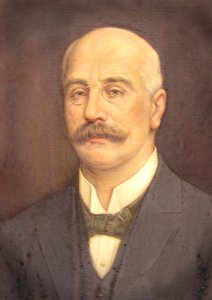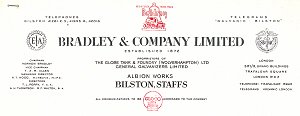 |
Bradley & Co. Ltd (Beldray) Mount Pleasant, Bilston |
 |
This company, founded in 1872 (which sadly ceased trading in 2005), was originally called Bradley & Co. Ltd., but changed its name to that of its famous trademark, becoming Beldray Ltd..
Its early history has been difficult to trace but we have been considerably assisted by Jaap Arriens, of the Netherlands, whose great grandfather was Walter Smith Bradley, the founder of the company. (One of W. S. Bradley's sons was Hector Bradley. His daughter married a Dutch army officer she had met in Birmingham during the second world war and they became Jaap's parents). Jaap has sent us a newspaper article about W. S. Bradley, written in 1908 but from a newspaper which cannot currently be identified; and a portrait of him.
 |
According to the newspaper report Walter S. Bradley was
born in 1854 and educated at Wolverhampton Grammar School.
The School Register (published in 1926) records, in 1866:
"Bradley, Walter Smith. July 1854. Son of Thomas
Bradley, Caponfield, Bilston. J. P.. Late of Somerset
Grange, Edgbaston. Died March 17th, 1918".
The newspaper says that his father's firm was Thomas and
Isaac Bradley - presumably the Caponfield furnaces - and
that they made pig-iron and other castings.
On leaving school Walter joined this firm in 1870 but after only two years, in 1872, he established Bradley's at the Albion Works "laying the first bricks of the new factory" himself. |
This means Walter was about 18 when he founded the company. As he was under 21 he was, in the law of the time a minor, unable to buy land and with limited powers to enter into contracts. One supposes that it was his father who backed the venture, financially and otherwise. It was a time of industrial boom in the UK and the hollowware trade was expanding. Father and son had seen an opportunity. Boom, of course, was followed, if not by bust, depression; and the newspaper notes that "foreigners ...Germans, Spaniards and Americans alike" had taken up the trade and had done so behind high tariff walls; and countries like Denmark and Australia were becoming self sufficient. It was this situation which lead Walter Bradley to expand from hollowware into iron stampings, tank making and the manufacture of sanitary ware. "Even recently Mr. Bradley opened up a branch in art metal work and this has now grown to considerable dimensions". This suggests a date, also suggested elsewhere, of about 1903 for the introduction of these brass and copper wares. That makes Bradley's a rather late entrant into that field, but it does not preclude the possibility that some items, such as copper kettles, were made before that date as part of a general hollowware business. But by the time of the report in 1908 "In brass and copperwork Bilston productions include kettles and urns, coal scoops and letter racks, salvers and cake stands, pin trays and fern pots, flower vases and rose bowls, mirrors and plaques, and even clocks mounted in antique copper, with decorated dials and fired enamels". The company continued to produce brass and copperware until 1939. These products have an increasing fame (and value) in the antiques world.
In 1908 the firm is reported as employing "some hundreds of workpeople" and to have the most up-to-date plant and "steam, suctions gas and electricity are variously employed as motive power". And it is said that Walter maintained a "friendly relationship" with his work people.
The newspaper also notes that on the death of his father, about 1898, Walter took over his interest in the "Capponfield Furnaces" and became a life director of that company. It also notes that he was a member of the Birmingham Chamber of Commerce and that he was a strong Unionist and Tariff Reformer and that he resides at Somerset Grange, Edgbaston. He had declined invitations to enter public life and in hsi limited spare time from work "his recreations have been restricted to riding and driving and, latterly, motoring". (The "driving" referred to would have been carriage driving).
By the time of this report, 1908, Walter Bradley was "assisted by his elder son, who was educated at Rossall School, and presently a younger son will be entering the firm of Braldey & Co. Ltd.".
Taking the family history a bit further forward, Jaap Arriens (following on from George Philpott's story) says
As far as I know Herman did indeed move from Birmingham to Shiplake-on-Thames and I am pretty sure he lived in a house along the Thames river, named "Eyot Wood".
As far as the First World War is concerned: Herman's brother Hector (my grandfather) left the works and joined the Army in the 6th Batallion of the South Staffordshire Regiment (Territorial Army). Hector must have had drills in the building of the Former Drill Hall on Mount Pleasant in Bilston. Hector was sent to Belgium and from there to the North of France. He was wounded on the 13th of October 1915 during a gas attack at the Battle of Loos. It was a gas attack by the British but, because of incorrect calculation of the wind, the gas was blown backwards (information by the In Flanders Fields Museum in Ypres, Belgium). Hector "was put with the dead and the dying" (as my mother told me), but miraculously survived and was sent back to England immediately, where the doctors told him that he would probably live for no more than 5 years. For the rest of his life he had to live with a stoma in his throat. He took years to recover, and died very dramatically in 1940!
I believe Herman did not join the forces, because he stayed in the factory to continue running the Albion Works.
The later company history, as we currently have it, appears from the contributions of George Phillpott and Brian Davies which are linked below. In outline we can says that the company continued with general domestic ware, based on iron and steel, with a variety of finishes, especially galvanised. These products include kettles, baking trays, saucepans, frying pans, buckets, pails, dustbins and the like. Their watering cans, especially those with brass roses, also now have a place in the antiques market. Their aluminium step ladders remain well known but their most famous product must be their ironing boards, which are found, giving yeoman service, all over the world. The company claims to be the first to have produced ironing boards in this country.

This letter head from 1953 (kindly provided by the Booth family) refers to the company as having been founded in 1872 and to it's being the "proprietors" of the Globe Tank & Foundry (Wolverhampton) Ltd. and General Galvanisers Ltd.. It gives the directors as Hermon Bradley (Chairman), T. A. W. Allen (Vice Chairman), T. T. Hood M.I.Mech.E., M.I.P.E (Managing Director), T. L. Perry, F.C.A., A. H. Thompson and R. F. Walton, B.A.. It also refers to their London address as 321/3 Grand Buildings, Trafalgar Square.
A search in A2A produces an entry from the Worcestershire Record Office, showing, in the papers of Messrs. Ivens and Hall of Kidderminster, dated 1962-63, documents relating to the sale of Lamb, Hingley & Co. Ltd. to Bradley & Co, of their business of the manufacture and sale of holloware pressed metal articles. Nothing more about this takeover has yet been found.
At a BCMC event in November 2006, Harold Marriott (a sometime Biston BC councillor) confirmed that Beldray owned the houses fronting Mount Pleasant, between the office block and the town centre. They were eventually auctioned off, in lots of two or three houses at a time but they now appear all to be in individual ownership (and Harold himself still lives in one of them). We were also told that Beldray also owned the block of houses on the other side of the office block. Mrs. Winifred Roberts (nee Barrett) bought hers direct from Beldray in 1978. She and her husband had lived in it for years before, her husband being one of their employees. But she did not buy it until after he husband and died. Another visitor, whose father had been the company's gate keeper, that the company's weighbridge was in the road which runs between the old Technical School and the old bus depot; and that the bowling green was at the back of the site behind that road.
In more recent years the company moved into safety equipment, such as the gates you put at the top of the stairs to stop children falling down, and they produced a wide range of such things.
However in March 2003 the company announced that it was moving production to the Far East and was reducing its work force from 300 to 100. Then, on 21st August 2004, it was announced that the company had called in the receivers, a spokeswoman saying that the company had fallen into difficulties "due to financial underperformance, which was compounded by competition from China". The usual hope was expressed that the company could be sold as a going concern, but the workers were sent home, unpaid. There was a brief splutter of renewed life but in 2005 the whole company closed for good.
We have the following pages about Bradley's. Click on any of them to go to them.
1. George Phillpott's "Short History" of the company - which he joined in 1933 - in four parts:
i. Before 1939
iii. From 1945 to 2005
2. Brian Davies' "Short Account" of the company - which he joined in 1976
3. Margaret Weston's photos of her father, Bill Chance - from the time he worked at Bradley's.
 |
| return to the Industry front page |